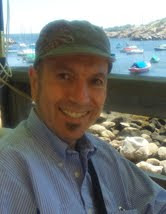When I was taught to paint, it was all outdoors, on location in Gloucester. That was about 20 years before I ever heard the term "plein aire." (Yes, there was an e on there... hey... it's French)
It didn't take long to see that what I painted in daylight looked horrifically bland (or at least different) in any of the indoor choices. So, I spent years apologizing for the effects of artificial lighting, and positioning my paintings near windows... or waiting for morning to arrive.
Back then there were no halogen bulbs, and the choice was either daylight, incandescent or florescent light bulbs in cool or warm varieties. I didn't like any of them.
Along the way I started selling my paintings in galleries, and eventually owned a gallery. That experience made me realize that two things mattered in selling art: How it appears in the gallery, and what it looks like in the buyer's home.
Since both situations usually featured artificial lighting, I decided to adjust my studio lights to match the gallery lights. Back then, the gallery lights were incandescent flood lights. When the norm switched to halogen floods, I adjusted my studio lights to match them.
(Before this gets too far - I think painting from nature is an invaluable experience for any artist, especially in the early learning phase. But upon maturing, we do not all have the luxury of time for painting excursions, and working in the studio becomes more attractive.
That said, painting at night became the alternative to not painting at all. In fact, for the past twenty years I have painted almost exclusively in the studio. But now it is from preference more than from necessity.)
Recently, the introduction of new energy-efficient florescent curlycue home lighting has changed residential color temperature dramatically. I think the new bulbs (at least the cheap ones I use) were designed to turn reds into browns. When I tried them in the studio my cadmium reds, quinacridone red, alizarin crimson and burnt sienna were nearly indistinguishable from each other. Yuk!
Paintings made under halogen or incandescent lights lost their reds and violets when viewed in a curlycue-lit room. This is a MAJOR problem for artists and galleries, because it is throwing a huge wild-card into the sales funnel. Aside from educating buyers about lighting choices, I'm currently at a loss on what the solution will be.
So, as a partial solution, I changed my studio lighting to 48" long 3500 Kelvin florescent bulbs made by Philips. The light is not as brilliant and focused as halogens, and I keep them about 4 feet away from the easel. The result is that when the paintings are under halogens in the gallery, they look even better. The colors sing. (That's a good thing.) Under the dim curlycue bulbs there's still a problem, but not as severe.
The painting above was made in my studio under halogen lights. I designed it from some photos I made on location, and a few sketches made from those photos, in the studio. The reds, oranges and violets looked great... until I brought the painting into my newly energy-efficient florescent-lit living room. Then suddenly the painting looked dull and brown!
The shock of that color shift led to my current studio lighting (mentioned above).
The lighting problems have not dampened my enthusiasm for studio painting over location painting. I have come to prefer being able to paint at my own schedule, day or night, and having an unchanging environment in which to paint.
So, maybe I'll start a new society of painters en plein light-bulb?
More paintings at BruceWoodArtist.com
Tuesday, February 14, 2012
Subscribe to:
Comments (Atom)
